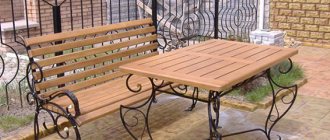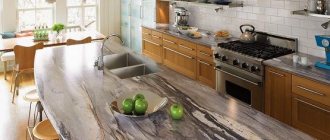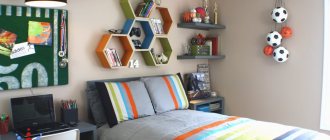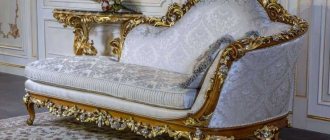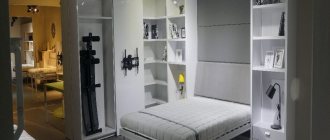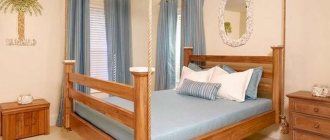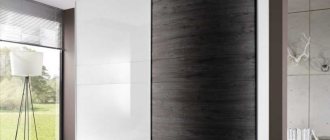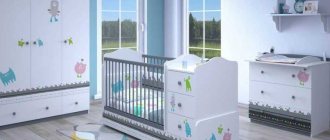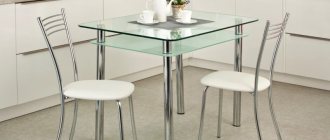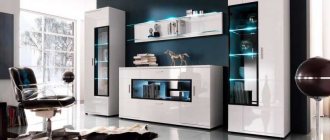Why do you need a plinth on the tabletop?
It is the countertop that serves as a kind of springboard where processing, cleaning, and slicing of products takes place. And even if you use a board, there is no insurance against small pieces of food getting into places that are hard to reach for cleaning.
The baseboard protects the space between the furniture and the wall from small elements and debris getting there. The plinth covers the space between the furniture and the wall. This could be a corner or any other shape. This improves the aesthetic appearance of the kitchen. How to attach a corner to a tabletop and what types there are, we will consider further.
With the right baseboard, the aesthetic appearance of the kitchen improves noticeably.
What is the baseboard for?
- Serves as a beautiful edging for the kitchen countertop. It helps give the cladding a finished appearance.
- Moisture or dirt will not collect in the cracks, which will prevent mold from occurring.
- The durability of the cladding and furniture increases, because moisture that could get into the gap could cause the wooden furniture to swell.
- If we are talking about special prefabricated skirting boards, then there is another advantage. Electrical wires can be laid in the cavity of the baseboard, which will make it easy to install an outlet in a new location.
What do you need to know to securely attach the baseboard to the countertop?
Features and types of kitchen skirting boards
Masking the joint between the headset and the wall is not the only task of the plinth. And despite the importance of aesthetics, protection from moisture and damage to furniture also needs to be taken into account.
The baseboard also protects furniture from excess moisture. When purchasing a new kitchen, the kit includes wall furniture plinths, joints and plugs. But there are often cases when a headset is assembled into separate elements. In this case, the manufacturer will not supply the furniture with skirting boards, which automatically makes the selection of this element your responsibility. The variety of materials and shapes is enormous.
As a rule, baseboards are included with new kitchens. We invite you to consider three main ways to select profiles:
- The most common phenomenon is the selection of kitchen plinths based on the characteristics of the working surface. If you order profiles and joints based on numbers or decor names, please note that the shade may differ from one manufacturer to another.
- Identity of materials. This means that the baseboard is made by the manufacturer from the same material as the kitchen unit. For example: if the tabletop is made of wood, a profile is cut from the main board for ideal compatibility and visual creation of a monolith.
- Third method. This method is more designer, because the selection of skirting boards is carried out on the basis of its maximum similarity with the color of the handles and the type of material.
You can select a plinth for a tabletop according to several principles.
When choosing a profile, first of all take into account its physical properties. Each material is individual.
Plastic
Active demand for plastic products is due to durability, practicality and affordability. The manufacturer achieves aesthetics and texture for plastic skirting boards by lamination. Color is formed by adding pigment. Hence the huge number of shades and options for simulating natural materials: wood, metal, stone and others.
Plastic skirting boards are in great demand. Invoice options:
- smooth;
- gloss;
- matte and shagreen.
Plastic skirting boards can have all sorts of textures. Plastic is also valued for its ease of installation, because it bends and cuts quite simply. The main bonus is moisture resistance. In fact, water cannot harm plastic in any way. Profiles made from this material are easy to wipe clean.
Installation of plastic plinth is quite simple.
Aluminum
Thanks to the process of adonization (coating the surface of the slats with a special film), a good protective layer is formed: durable and moisture-resistant. Such profiles last much longer than the headset itself.
These skirting boards are durable and moisture resistant. PVC skirting boards have a drawback - they are “afraid” of exposure to high temperatures, which is not typical for aluminum. In addition, it is an electrical insulating material. The cost is slightly higher than that for plastic products.
One of the disadvantages is that they do not tolerate too high temperatures.
Metal-plastic
Metal-plastic products combine the advantages of previous profiles. Despite the advantages that aluminum and PVC models have, metal-plastic actually has no disadvantages. Among the possible ones: lack of flexibility (impairs the ability to hide wall irregularities with a tight fit) and some installation problems.
One of the main disadvantages of such skirting boards is that they are difficult to bend.
Fillet selection
In order to choose the right plinth for the kitchen countertop, consider its functions and characteristics.
Functions
Why do you need a plinth on a kitchen countertop? Is it only a decorative element or, by closing the gap between the surface of the table and the plane of the wall, does it also have a practical purpose?
Let's answer these questions and highlight the main advantages of installing wooden, aluminum and plastic skirting boards:
- Disguise. The walls may have unevenness or other design features that prevent the table from being placed flush. You can safely design the location of kitchen furniture at some distance from the surface of the walls. A kitchen plinth for the countertop will perfectly close the gap, and the entire interior will look in place.
- Protects from debris. Crumbs, crumbs and more crumbs! Can you imagine how many different types of small waste can accumulate over a long period of time in such an inaccessible place? Further occurrence of fungi and mold will clearly adversely affect the environmental friendliness of the premises.
- Water protection. Pay attention to the photo below. The kitchen plinth for countertops protects not only from crumbs, but also from dripping onto the back wall of the kitchen furniture. This protects the table material from getting wet and subsequent swelling.
Frieze around the sink
Tip: if your kitchen furniture is made of MDF, then you should choose a higher quality fillet. Since such material is especially sensitive to water getting on it.
Material
When ordering a ready-made project, the plinth for the kitchen countertop is already included. If you have an individually assembled kitchen, then you can choose the baguette yourself.
For wooden furniture, manufacturers recommend a frieze made of wood or at least laminated chipboard. A granite countertop can be equipped with an artificial stone baguette.
You should know: the fillet is selected from a material similar to the material of the countertop. The exception is the plastic frieze, which can successfully imitate products made from other raw materials.
Stone fillet
The most common are skirting boards for kitchen worktops made of plastic and aluminum.
Let's look at them in more detail:
- Frieze made of plastic. Made from polyvinyl chloride by co-extrusion. Co-extrusion is the process of making a baguette by adding a pigment that determines the color to the still molten plastic. This gives it a natural color.
By additional lamination, such a product can give the appearance of wood, stone or even metal. This makes it possible for it to be used in combination with almost any countertop.
Important advantages are also:
- low price;
- increased moisture resistance;
- ease of installation.
Variety of colors for plastic fillets
- Aluminum frieze. It is easy to clean, washable, and its cost is not much higher than its plastic counterpart. It also has one very important advantage - heat resistance. It can be installed in the area of a gas furnace without any fear.
But it cannot boast of such variety as a PVC product. Most likely, it is only suitable for countertops made of stainless steel or other similar material.
Reliability and practicality of aluminum
Advice: to achieve the best combination of table surface and baguette, it is advisable to order them from one manufacturer.
Even if you carry out the installation yourself, you will still purchase the necessary components in one place. When purchasing universal products, make sure that the edge holders are transparent. Otherwise, they can stand out quite strongly from the rest of the structure.
Depending on the design of your countertop and the location of the gas stove on it, pay special attention to the heat resistance of the fillet. Thus, wooden and plastic friezes are significantly inferior to aluminum products in this matter.
Form
The choice of the shape of the baguette we need is primarily influenced by the functional properties of the product. Namely, the dimensions of the kitchen plinth for countertops.
The larger the gap between the wall and the furniture, the larger the fillet should be. Otherwise, it will not be able to completely cover the void and will not protect against water and debris getting there.
The shape of the plinth is as follows:
- flat;
Flat frieze
- triangular;
Triangular frieze
- rectangular;
Rectangular frieze
- rounded;
Rounded frieze
- curly;
Figured frieze
Unlike the size, you can choose any shape. It all depends on your tastes and preferences.
You should know: wooden and plastic fillets have the greatest variety of shapes.
Types of skirting boards by design
It is not only the type of material that allows you to classify skirting boards and influences their choice. There are differences in design. There are only such varieties: universal and cast profile. The characteristics of each type are important when choosing. And it’s fair to consider both options to get an objective picture.
The profile of the skirting boards can be cast and universal.
Universal
A design feature of universal skirting boards is the presence of silicone seals. The inserts are replaceable, and their appearance is decorative. The plinth is easier to change due to the type of joint. The protruding edge holders can be confusing. The length of the profile sections is on average 35 cm. It is quite convenient to install.
Universal skirting boards have a silicone seal.
Cast
The type of construction assumes an increased level of rigidity and massiveness. The absence of a silicone profile implies attachment to the seal. Among the visible advantages: long service life and presentable appearance. Their dimensions are almost 10 times larger than the previous version of the design.
Cast plinth is more durable and massive.
How to replace a baseboard
This will require dismantling the old product. In this regard, self-adhesive options and strips installed with glue will be less convenient than material attached to hardware. Removing the old baseboard begins with removing the screws. They are unscrewed after removing the decorative trim or immediately if the latter is not provided for by the design. Before installing a new frieze, you need to make sure that the material is complete and select fasteners. With the second point, everything is simple, but in the first case, you will need to calculate the straight and corner connections of the plinth itself. The upper bar is checked for compliance with the basis, even at the purchase stage. The following steps repeat the principle of conventional installation. First, the parameters of the countertop are measured, then fragments of the required length are obtained, and then gradual installation begins. With drilling holes if hardware will be used.
What are the differences and which type should you choose?
Composite section
The category is considered the most popular, including products made from aluminum, stainless steel and plastic. The profile is based on 2 parts: the back and front parts. In the first case, the role of the component is fixation (base). The decorative function is performed by the front side. There is also an option to introduce a third panel - decorative tape. It can imitate metal and countertop material.
Such skirting boards have two parts in the profile - front and back. Grooves are provided for tightly holding and fixing the decorative tape. Plastic parts are used as mounting elements.
Complete with:
- plugs (ensuring aesthetics);
- internal corner;
- outer.
Can be equipped with plugs and corners.
Calculate the number of installation kits in advance so as not to go to the store twice.
Solid section
Found in skirting boards such as borders. This class of products includes a wide variable range of products made to order. For example, artificial stone, granite, wood, ceramics, etc. Not very common, but included in the same group of skirting boards, are made of stainless steel.
The materials for making solid plinths can be almost anything. Disadvantages are manifested in high cost and the absence of a silicone seal. Processing and installation can also be considered disadvantages.
Disadvantages include high cost and complex installation.
Installing a baseboard for a countertop
As soon as the choice of kitchen baseboards is completed, you can begin their installation. Of course, such work requires careful preparation, one of the main points of which is the search for the necessary tools and materials.
Preparing tools
To install kitchen moldings, you need to prepare the following tools:
- hacksaw for metal;
- transparent silicone in a tube;
- carpenter's knife;
- set of self-tapping screws;
- screwdriver;
- tape measure, ruler or other measuring device.
Preparing tools for work
Prices for the popular range of miter saws
Along with skirting boards, stores sell decorative corners that can be used to hide the joints. There are end, external and internal corners. All of them are attached to the surface of the baseboard using silicone. If the corners are purchased separately from the molding, then you need to choose them in such a way that the products match perfectly in color.
Decorative corners for skirting boards
Instructions
The process of installing skirting boards in the kitchen is simple if everything is done according to the recommendations and rules. Below are step-by-step instructions, following which will greatly facilitate the work.
Step 1 . Measure the length of the tabletop and cut the required pieces of baseboard. To do this, you need to use a metal saw to make the cuts as even as possible.
Cut the skirting board to the required length
Step 2 . Divide the plinth into two parts - internal and external. You need to start working with the base of the molding, that is, with its inner part.
Dividing the baseboard into two parts
Step 3. Screw the base of the baseboard to the tabletop using a screwdriver. Instead of self-tapping screws, some craftsmen use glue, but in this case it will be impossible to carefully remove the installed baseboard. The optimal distance between screws is 15 cm.
Step 4. Once the base is screwed on all sides, proceed to install the decorative part of the baseboard. First you need to install the latch on one side, and then proceed to install the joining angle.
The joining angle is set
Step 5. When installing the joining angle, you need to remember that the front part of the plinth must extend under it by at least 5 mm. The corner itself is fixed with glue.
Glue is used to fix the corner
Step 6 . Using a tape measure, measure the desired length of the second baseboard, leaving a small gap so that part of the face latch is under the corner. If necessary, cut off the excess part of the baseboard.
The length of the second plinth is measured
Step 7 . Insert the upper part of the plinth under the decorative corner and press it against the base until a characteristic click appears. This means that the plinth is securely fixed.
The upper part of the plinth is inserted
Step 8. The edges of the plinth are closed with special plugs, which are sold complete with decorative corners. They will hide the cut area of the baseboard, thereby improving the overall appearance. The plugs are easy to install, you just need to press them.
Special decorative plug
Step 9 . This is what the finished plinth looks like. If all installation steps were correct, then the mounted molding will preserve this type of kitchen for a long time. To eliminate the possibility of water getting into the seams formed between the wall and the edge of the table top, this area must be treated with a sealant.
Installed kitchen plinth
How to attach a plinth to a tabletop
Among the main methods of fastening, there are 2 main ones: screws and glue. Here everything depends on the presence/absence of special holes for self-tapping screws, the characteristics of the material, its ductility, flexibility and other aspects. Let's consider both methods in detail.
You can attach the plinth using self-tapping screws or glue.
Fastening with self-tapping screws
This method is considered more reliable, so it is often chosen. Technical implementation is also not difficult.
This fastening method is considered the most reliable. Algorithm for fastening with self-tapping screws:
- The decorative panel must be separated from the base.
- Set the number of accompanying materials required for installation (plugs, corners).
- Lay out the structure (in fragments). This will help determine whether there are enough materials for the work and will indicate whether there is a need to adjust some of them to length.
- Not all baseboards have silicone seals. If they are missing, you need to degrease the surface of the countertop and apply a small layer of silicone.
- Installation work is carried out from the corner, along the surface of the tabletop. The step of fixing the base of the plinth with self-tapping screws should not exceed 30 cm, but it should not be less than 20.
- For reliable installation and optimal fixation, self-tapping screws are selected galvanized, or, if not available, brass. They are not afraid of metal corrosion.
- To ensure that the screws hold tightly, dowels are first driven into the wall into pre-prepared holes.
- The front strip is installed immediately after fixing the base. The ends of the plinth are covered with plugs for aesthetics.
The plugs may not always fit tightly. In this case, plant them with rubber glue or silicone.
It is better to fix the plugs with silicone or rubber glue.
Glue mount
Borders can be glued to the surface using liquid nails. If there is a need to glue skirting boards made of artificial stone, then you need to choose acrylic-based, two-component substances. To ensure that the joints remain invisible, the color of the glue is selected individually.
As a rule, liquid nails are used for gluing. The algorithm for carrying out the work does not differ from fastening with self-tapping screws, with the exception of:
- the need to degrease the surface for reliable fixation of the glue;
- the need to wipe off the remaining glue immediately until it dries (excess);
- there is no need to prepare connectors or drill anything.
On uneven surfaces you need to use more glue. In places where the surface is uneven, you need to use a thicker layer of glue. It's easier and faster to work with glue. But the screws still fix it stronger and more reliably.
How to replace a baseboard
This will require dismantling the old product. In this regard, self-adhesive options and strips installed with glue will be less convenient than material attached to hardware. Removing the old baseboard begins with removing the screws. They are unscrewed after removing the decorative trim or immediately if the latter is not provided for by the design. Before installing a new frieze, you need to make sure that the material is complete and select fasteners. With the second point, everything is simple, but in the first case, you will need to calculate the straight and corner connections of the plinth itself. The upper bar is checked for compliance with the basis, even at the purchase stage. The following steps repeat the principle of conventional installation. First, the parameters of the countertop are measured, then fragments of the required length are obtained, and then gradual installation begins. With drilling holes if hardware will be used.
Rules of care
The main function of the baseboard as a barrier is to prevent liquid or solid household waste, which has the ability to decompose under the influence of the kitchen microclimate, from getting into hard-to-reach places. Therefore, if gaps appear between the tabletop and the baseboard, they need to be eliminated. Transparent silicone is suitable for this.
It is important to ensure that no gaps form between the baseboard and the wall. Otherwise, there are no special care rules (except for the obvious - avoid contact with hot objects if the profile is PVC).
Methods for connecting tabletop parts
To connect the joint of a kitchen countertop, use one of 3 types of work:
- joint to joint without euro-saw;
- with euro saw;
- using a T-shaped metal profile.
Joining butt to butt without a euro saw does not require special tools or knowledge. It's simple and economical. The parts of the tabletop are installed to each other at an angle of 90°, the surface is leveled using a building level. If done correctly, the seam will be almost invisible.
However, such a connection is not airtight and is susceptible to moisture and temperature fluctuations. Over time, the ends swell and become unusable. The connection itself is fragile - heavy objects cannot be placed on it.
Important! If parts of the furniture are initially deformed, it will not be possible to fit them together smoothly.
When eurosawing, the ends are processed according to the pattern. The cuts are made using a milling machine. To reduce costs, manufacturers process furniture on a format-cutting machine, thereby obtaining uneven planes of the ends with an allowance of 1 mm or more. As a result, they do not fit tightly, and gaps appear between the parts being connected.
When joining parts processed by a milling machine, the resulting gap is a fraction of a millimeter, which is invisible to the naked eye. Visually the surface is solid. This result can only be obtained with high-quality equipment, and the machine must be installed perfectly level and the patterns must not be worn out.
Reference! If the countertop has a dark finish, it will be difficult to find a connection with a euro saw.
This connection is lockable, so the parts of the table top must be located in certain places. They should not be rotated so as not to disturb the structure and not lead to the formation of a gap. The corners of the room must be correct. If they are uneven, a gap is formed between the wall and the tabletop, which is best closed with a furniture plinth. If there is a large curvature, this will not help and you will have to straighten the corners of the room.
When installing a U-shaped set in a room with uneven walls, cracks form along each surface. Covering them with a plinth will not work. In this case, the set is installed as close to the walls as possible, leaving gaps between the parts of the tabletop and closing them with a T-shaped strip.
When joining a tabletop using a T-shaped aluminum profile, the locking fasteners are not cut out; the seam is covered with a strip . To make the connection airtight, the vertical upright of the profile and the ends of the furniture are treated with silicone sealant. This connection is more practical than a Euro saw.
The countertop is usually connected near the sink, which is mounted in the corner. Water from the sink getting into the gap causes the Euro saw to swell. At the same time, the metal strip treated with sealant is impermeable to liquids - it preserves the appearance and service life of the countertop. If moisture gets under the profile, its horizontal wings will prevent the furniture from swelling.
This is interesting:
What are the benefits of quartz agglomerate countertops for the kitchen?
Stainless steel kitchen countertops.
Using clear epoxy resin to fill the countertops.
